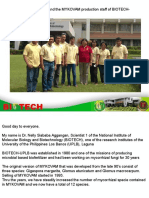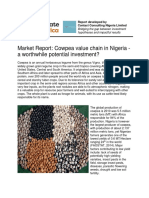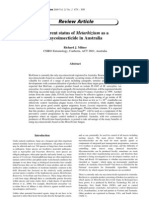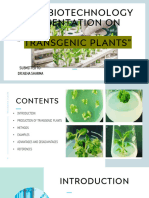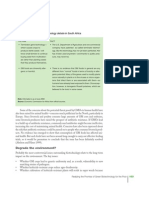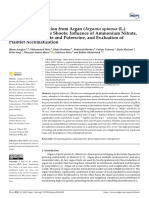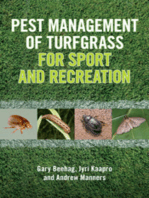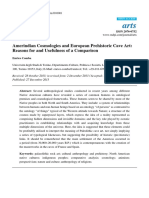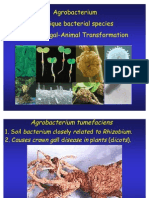Successful Truffle Cultivation Runs On Science: Mycorrhiza Biotech
Successful Truffle Cultivation Runs On Science: Mycorrhiza Biotech
Uploaded by
Bogdana BogdanCopyright:
Available Formats
Successful Truffle Cultivation Runs On Science: Mycorrhiza Biotech
Successful Truffle Cultivation Runs On Science: Mycorrhiza Biotech
Uploaded by
Bogdana BogdanOriginal Title
Copyright
Available Formats
Share this document
Did you find this document useful?
Is this content inappropriate?
Copyright:
Available Formats
Successful Truffle Cultivation Runs On Science: Mycorrhiza Biotech
Successful Truffle Cultivation Runs On Science: Mycorrhiza Biotech
Uploaded by
Bogdana BogdanCopyright:
Available Formats
Successful Truffle Cultivation Runs on Science
Mycorrhiza Biotech – Copyright 2017
Table of Contents
TABLE OF CONTENTS ............................................................................................................................................2
INTRODUCTION .......................................................................................................................................................3
BACKGROUND ..........................................................................................................................................................4
SOLUTION ..................................................................................................................................................................5
COMMERCIAL VIABILITY ....................................................................................................................................6
CONCLUSION ............................................................................................................................................................ 7
WORKS CITED ..........................................................................................................................................................7
Mycorrhiza Biotech – Copyright 2017 2
Introduction
Truffles are a prized fungal delicacy due to their unique organoleptic and culinary qualities. Production of
truffles in traditional producing nations has been declining steadily for over half a century, while worldwide
truffle consumption continues to rise (Hall et al. 1994). According to the USDA Foreign Agricultural
Service, imports of truffles more than doubled from $6.6 in 2008 to $16.8 million dollars in 2015.
Significant investment is currently being made into growing truffles as a specialty crop in the United
States (e.g., the NC Biotechnology Center and the NC Tobacco Trust Fund ). Many factors beyond
culinary use contribute to the desirability of the truffles, specifically the white spring truffle, Tuber borchii.
They include:
Forest preservation and Variety of host trees: pine, oak,
Co-cropping trees with truffles
conservation hazel, poplar, beech, chestnut,
provides additional income for land
owners linden, alder, and cedar
Accelerated host plant growth and Truffle Benefits Improved host plant health and
development drought resistance
Imports more than doubled- $6.6
Fruiting occurs at a wide range of Harvest: Specially trained dogs
million in 2008 to $16.8 million in
pH (pH 5 – 8) (opportunity to save shelter dogs)
2015. (USDA Foreign Agricultural
Service)
There are a multitude of obstacles to successful truffle production outside their native geographic areas.
The three biggest obstacles to maintaining vibrant thriving orchards with bountiful harvests are
seedling/mycorrhization quality, contamination, and cost.
• Seedling quality/Confirmation - Confirming whether a seedling has the correct truffle fungus
(e.g. Tuber borchii) inhabiting its root system is key to successful truffle production. Until recently
truffle farmers and seedling producers in North America depended on the unreliable
morphological characteristics of roots to “guess” whether their trees have the intended truffle
fungus on them.
Contamination - The major problems in truffle cultivation are contamination by competing
fungi/micro-organisms, poor quality nursery stock, or replacement of truffle mycorrhizae by
indigenous mycoflora after planting.
• Cost – Regular loblolly pine seedlings cost $0.16 through state nurseries, while mycorrhized
seedlings cost $33 - $35. Through our efforts to maximize the production process and streamline
our protocols we have been able to reduce the price
to $30, but it still remains comparatively high. “Contamination, poor quality nursery
stock, or replacement of truffle mycorrhiza
Using innovative DNA-based diagnostics for truffle by indigenous mycoflora after planting are
detection and mycorrhized seedling propagation, all possible detriments to truffle orchards
Mycorrhiza Biotech provides a unique and crucial that could easily go unnoticed by a truffle
farmer.”
science-based protocol and orchard management – Dr. Omon Isikhuemhen, Professor and
system for successful truffle cultivation for the Researcher working on truffles at NC A&T
growing truffle industry in North America. State University
Mycorrhiza Biotech – Copyright 2017 3
Background
Mycorrhiza Biotech, LLC is an agribusiness that develops products and services that improve plant
production. Our patent-pending technology that uses a natural resource, loblolly pine (Pinus taeda), to
cultivate a high-value crop, gourmet truffles, while simultaneously improving the tree's productivity has
wider implications for overall forest health. Most people are unaware of the crisis threatening our nation’s
trees, but Mycorrhiza Biotech is a step ahead. The Guardian newspaper carried an article on September
19, 2016, “An American tragedy: why are millions of trees dying across the country?” Describing “ A quiet
crisis playing out in US forests as huge numbers of trees succumb to drought, disease, insects and
wildfire – much of it driven by climate change”
The benefits of mycorrhiza extend beyond truffle income. Highly mycorrhized trees encourage plant
health, keep pathogenic organisms at bay, and help trees survive in harsh conditions. Other benefits of
mycorrhizae include:
Enhanced plant efficiency in absorbing water and nutrients from the soil
Reduced fertility and irrigation requirements
Increased drought resistance
Increased protection/resistance to pathogens
Enhanced plant health and stress reduction
Enhanced seedling growth
“Forestry officials and scientists are increasingly alarmed, and say the essential role of trees – providing
clean water, locking up carbon and sheltering whole ecosystems – is being undermined on a grand
scale.” (The Guardian, 2016).
Mycorrhiza Biotech’s successful endeavor to cultivate gourmet truffles parallels the ongoing effort in the
scientific community to address the crisis decimating America’s forests. Highly-mycorrhized trees are
better prepared to withstand the damage from climate change and pests many forests are currently
experiencing. To maintain control, avoid contamination, and ensure our trees are highly-mycorrhized, we
propagate our truffle colonized seedlings under stringent nursery conditions. The mycorrhized seedlings
are later planted in orchards that have been meticulously prepared. Careful cultivation and management
has led to truffle production after only 2 years and 3 months – much faster than the typical 4 – 6 years for
previously recorded harvests.
The ability to detect the truffle fungus under cultivation and competitor fungi on host roots and in the
rhizosphere is vital to successful truffle farming. Plants that have either no truffle or the wrong fungi in its
roots should not be planted. Heavily colonized root systems in nursery and out-planted seedlings are
indicative of good management practices. Many truffle farmers and seedling producers in North America
have depended on the unreliable morphological characteristics of roots to “guess” whether their trees
have the intended truffle fungus on them. However, Mycorrhiza Biotech’s protocols for mycorrhized
seedling production and farm management systems have added the necessary layer of science to pivotal
points on the truffle cultivation process mitigating risk and adding certainty. The advent of our recent
early harvest of Tuber borchii establishes proof that our proprietary systems are solid, effective, and
reliable.
“Confirming whether or not a tree has the
correct truffle fungus inhabiting its root
system has critical orchard management
implications.”
- Dr. Omon Isikhuemhen
Mycorrhiza Biotech – Copyright 2017 4
Solution
The benefits of mycorrhizae are well known. The image below describes how the fungus “protects” the
host plant roots literally acting as a shield preventing pathogenic organisms from gaining access to and
harming the tree.
Source - NC A&T State University, Mushroom Biology and Fungal Biotechnology Lab
We have demonstrated that the cultivation of truffle inoculated pine trees can be an alternative to
traditional forestation, whereby the truffles serve as a value added crop that will generate additional
income for the forest owners while keeping the orchard healthy and vital. This co-cropping practice will
increase reforestation, enhance plant growth and development through symbiotic association between
the plants and the truffle fungi, as well as improve microbial diversity in pine forest environments.
Mycorrhiza Biotech’s solution includes a comprehensive approach to truffle farm management specifically
for timber management companies and land owners that use pine. Our methods use science as the
foundation for the 6 Steps to Successful Truffle Farming:
.
Mycorrhiza Biotech – Copyright 2017 5
Mycorrhiza Biotech’s solution facilitates the long-term goal to integrate truffle farming into agroforestry
practices as a means of reforestation, and soil conservation, and to determine optimal silviculture
practices for truffles in the forest environment of North Carolina specifically and in North America in
general.
Commercial Viability
Mycorrhiza Biotech is the only company with established orchards producing truffles on Pinus taeda in
North America. Mycorrhiza Biotech is the only company with truffle inoculated seedlings in production in
2 years and 3 months after planting. Our protocols and management systems are unique because we
confirm the presence of the truffle fungus on the seedling prior to planting thereby reducing risk.
Our technology uses micro-propagation and biotechnology tools to propagate truffle mycorrhized
seedlings. Our trees are evaluated and determined to have high rates of colonization before being
released to our customers.
Co-cropping timber with gourmet truffles capitalizes on an opportunity and is a win-win for farmers,
foresters, foodies, and state revenue offices. Tuber borchii, a white spring truffle has a current market
price of $500/lb. Nearly 1 billion loblolly pine seedlings were planted in 2015 in the Southeastern United
States (Scott Enebek, 2017) with over 12 million in NC alone (Drew Hinnart, 2017). Each acre can
generate approximately $3000 in wood products over 36 years. Co-cropping Tuber borchii with loblolly
pine will provide growers with an additional $50,000 of income per acre over the truffle production cycle
starting as early as year 4. There is a huge opportunity to reforest our nation with highly-mycorrhized
trees that are better prepared to withstand climate change and pest damage our forests are currently
experiencing. Our product helps farmers and forests thrive.
Mycorrhiza Biotech – Copyright 2017 6
Conclusion
This white paper is designed to outline the best approach to establishing healthy truffle orchards.
Applying scientific principles and protocols to the truffle production process greatly increases the harvest
opportunities. Mycorrhiza Biotech’s scientific approach to truffle farming addresses the three primary
obstacles to successful truffle cultivation which include Cost, Contamination, and Seedling
quality/Confirmation. Our trees have produced truffles in nearly half the time as other measured
orchards. Additionally, our production systems have the potential to mitigate the current threats to
America’s forests. Successful truffle cultivation is an exact science. Mycorrhiza Biotech’s orchard
establishment and management systems remove all guesswork from the process.
If you want to be successful, trust the science behind our fruitful orchards.
Works Cited
1 – Hall, I., G. Brown, and J. Byars. 1994. The Black Truffle. 2nd Ed. New Zealand Institute for
Crop and Food Research, Christchurch, New Zealand.
2 - The Guardian – “An American tragedy: why are millions of trees dying across the country?” Oliver
Milman and Alan Yuhas September 2016.
3 – Scott Enebak, Southern Forest Nursery Management Cooperative at Auburn University, January
2017, Personal Communication.
4 – Drew Hinnant, NC Forest Service, Claridge Nursery, January 2017, Personal Communication.
Mycorrhiza Biotech – Copyright 2017 7
You might also like
- Mykovam Powerpoint Presentation 2016Document45 pagesMykovam Powerpoint Presentation 2016Alexis de Manuel100% (9)
- Nursery Screening for <i>Ganoderma</i> Response in Oil Palm Seedlings: A ManualFrom EverandNursery Screening for <i>Ganoderma</i> Response in Oil Palm Seedlings: A ManualNo ratings yet
- Chap 7Document17 pagesChap 7Arindam LayekNo ratings yet
- Mushroom CultivationDocument24 pagesMushroom Cultivationapi-374028892% (12)
- Mushroom Cultivation and MarketingDocument24 pagesMushroom Cultivation and MarketingNguyễn Lê Quốc ThiNo ratings yet
- Centro de Pesquisa Jatropha CurcasDocument4 pagesCentro de Pesquisa Jatropha CurcasbiodieselnetNo ratings yet
- Advances in Propagation of Ficus Carica L.: Avanços Na Propagação Da FigueiraDocument13 pagesAdvances in Propagation of Ficus Carica L.: Avanços Na Propagação Da FigueiraAntonioFlávioFerreiraNo ratings yet
- Button Mushroom Cultivation: GH. Hassan DarDocument33 pagesButton Mushroom Cultivation: GH. Hassan DarFungai Tendekai Mafuva MatembaNo ratings yet
- Aphidoidea) On Pechay (Brassica Rapa Linn.) Plants Worked On The FollowingDocument5 pagesAphidoidea) On Pechay (Brassica Rapa Linn.) Plants Worked On The FollowingRaquel Paleyan CalawenNo ratings yet
- SK MushroomDocument33 pagesSK MushroomPhoenix On FosterNo ratings yet
- JPDS2.35mushroompaperVol. 7 5edit139 43Document6 pagesJPDS2.35mushroompaperVol. 7 5edit139 43PRAJIT BHADURINo ratings yet
- 5fddafce43c60977 PDFDocument12 pages5fddafce43c60977 PDFJaber AlbaajNo ratings yet
- Agra Innovate Market Report - Cowpea Value Chain in NigeriaDocument4 pagesAgra Innovate Market Report - Cowpea Value Chain in NigeriaebubecNo ratings yet
- Commercial Flower Production Methodology: PropagationDocument6 pagesCommercial Flower Production Methodology: PropagationWidelp WidelpNo ratings yet
- MushroomDocument33 pagesMushroomManoj kumarNo ratings yet
- OrganicStrawberryProduction ATTRADocument28 pagesOrganicStrawberryProduction ATTRAFelicity1No ratings yet
- La Polinización Por Murciélagos Mejora Tanto La Calidad Como El Rendimiento de Un Importante Cultivo Comercial en MéxicoDocument10 pagesLa Polinización Por Murciélagos Mejora Tanto La Calidad Como El Rendimiento de Un Importante Cultivo Comercial en MéxicoAndrea Real NúñezNo ratings yet
- Clonal ForestryDocument91 pagesClonal Forestrylala laluNo ratings yet
- RmplasmDocument23 pagesRmplasmIris MoralesNo ratings yet
- Current Status of Metarhizium As A Mycoinsecticide in AustraliaDocument4 pagesCurrent Status of Metarhizium As A Mycoinsecticide in Australiacuongnguyen2000No ratings yet
- Biopesticides Biopesticides: - Class TeacherDocument22 pagesBiopesticides Biopesticides: - Class TeacherFaiza Noor100% (1)
- Teri MicorisaDocument7 pagesTeri MicorisabiodieselnetNo ratings yet
- Revised Thesis 011350Document37 pagesRevised Thesis 011350Rozelle BantiloNo ratings yet
- Term Paper ON: Transgenic PlantsDocument17 pagesTerm Paper ON: Transgenic PlantsVikal RajputNo ratings yet
- PCR Mori ReviewDocument15 pagesPCR Mori ReviewRay MrinalNo ratings yet
- Agr21 Write UpsDocument10 pagesAgr21 Write UpsGenesis Joy MarbellaNo ratings yet
- Truffles Truffles & Other Edible Mycorrhizal Mushrooms PDFDocument6 pagesTruffles Truffles & Other Edible Mycorrhizal Mushrooms PDFmtanaydinNo ratings yet
- Shreya Jindal PPT 2Document13 pagesShreya Jindal PPT 2Shreya JindalNo ratings yet
- 2011 Savoie & Largeteau AMB RevueDocument10 pages2011 Savoie & Largeteau AMB RevueDan CretuNo ratings yet
- Box 3.8 (Continued) : Fact and Fiction in The Biotechnology Debate in South AfricaDocument6 pagesBox 3.8 (Continued) : Fact and Fiction in The Biotechnology Debate in South AfricaHansCoilNo ratings yet
- Comparative Study On A Cultivation of An Oyster Mushrooms Using Nutrition Enhancing SubstratesDocument8 pagesComparative Study On A Cultivation of An Oyster Mushrooms Using Nutrition Enhancing SubstratesCathrine Mandap SantosNo ratings yet
- Advances in Blueberry Vaccinium SPP in Vitro CultuDocument21 pagesAdvances in Blueberry Vaccinium SPP in Vitro CultuRaluca-Cristina GuriencuNo ratings yet
- Afr J BiotecDocument11 pagesAfr J BiotecAugustine CrystalNo ratings yet
- Plant BreedingDocument5 pagesPlant BreedingbutterfilyNo ratings yet
- Tissue Culture As A Plant Production Technique For Horticultural CropsDocument8 pagesTissue Culture As A Plant Production Technique For Horticultural CropsSoummyadip RoyNo ratings yet
- Biotechnology and Its ApplicationsDocument10 pagesBiotechnology and Its ApplicationskusshhalNo ratings yet
- Integrated Pest Management in Wheat ProductionDocument20 pagesIntegrated Pest Management in Wheat Productionmahsa_motlagh100% (2)
- Micropropagation of Four Blueberry Cultivars: June 2015Document18 pagesMicropropagation of Four Blueberry Cultivars: June 2015franklinNo ratings yet
- Biotechnology Task Force MembersDocument16 pagesBiotechnology Task Force MembersTristanjames BanalNo ratings yet
- Integrated Pest Management For CacaoDocument59 pagesIntegrated Pest Management For CacaoPlantacion de Sikwate100% (11)
- Button Mushroom Cultivation (3) 2Document32 pagesButton Mushroom Cultivation (3) 2Fungai Tendekai Mafuva MatembaNo ratings yet
- Jojwb MS Id 555583Document4 pagesJojwb MS Id 555583Mariana PollNo ratings yet
- Highbush Blueberry Cultivation Protection BreedingDocument14 pagesHighbush Blueberry Cultivation Protection BreedingMustapha TayBiNo ratings yet
- Meristem CultureDocument18 pagesMeristem CultureAbster1No ratings yet
- Bio 309 - 0Document63 pagesBio 309 - 0okiprotich0No ratings yet
- Fungi As BiofertilizerDocument9 pagesFungi As BiofertilizerNeetuNo ratings yet
- 0713 04 Nature Agriculture Feedingthefuture ArtigoGratapagliaDocument5 pages0713 04 Nature Agriculture Feedingthefuture ArtigoGratapagliavanderbroNo ratings yet
- Meristem CultureDocument21 pagesMeristem Culturedreamers 22No ratings yet
- In Vitro Root Induction From Argan Argania Spinosa 220907 201120Document16 pagesIn Vitro Root Induction From Argan Argania Spinosa 220907 201120PlastiferNo ratings yet
- Plant Biotechnology in Seed ScienceDocument18 pagesPlant Biotechnology in Seed Sciencebuhlemgoboza100No ratings yet
- Disease Management in Cleome Gynandra: A ReviewDocument7 pagesDisease Management in Cleome Gynandra: A ReviewInternational Journal of Innovative Science and Research TechnologyNo ratings yet
- Developing A Superior Maize Hybrid: Pioneer Hi-Bred International, IncDocument18 pagesDeveloping A Superior Maize Hybrid: Pioneer Hi-Bred International, IncIs AizatNo ratings yet
- <i> Trichoderma</i>: <i> Ganoderma </i> Disease Control in Oil Palm: A ManualFrom Everand<i> Trichoderma</i>: <i> Ganoderma </i> Disease Control in Oil Palm: A ManualNo ratings yet
- The Mycophile's Handbook: From Spores to Harvest: Your Comprehensive Guide to MushroomFrom EverandThe Mycophile's Handbook: From Spores to Harvest: Your Comprehensive Guide to MushroomNo ratings yet
- Save and Grow: CassavaFrom EverandSave and Grow: CassavaRating: 5 out of 5 stars5/5 (1)
- Taming The Truffle References Edited Plus Additions PDFDocument42 pagesTaming The Truffle References Edited Plus Additions PDFBogdana BogdanNo ratings yet
- The Truffle and Its Cultivation in France: Acta Botanica YunnanicaDocument9 pagesThe Truffle and Its Cultivation in France: Acta Botanica YunnanicaBogdana BogdanNo ratings yet
- Amerindian Cosmologies and European Prehistoric Cave Art: Reasons For and Usefulness of A ComparisonDocument14 pagesAmerindian Cosmologies and European Prehistoric Cave Art: Reasons For and Usefulness of A ComparisonBogdana BogdanNo ratings yet
- MCIA KuwaitCultureGuide PDFDocument20 pagesMCIA KuwaitCultureGuide PDFBogdana BogdanNo ratings yet
- The City of Oslo: Intercultural ProfileDocument19 pagesThe City of Oslo: Intercultural ProfileBogdana BogdanNo ratings yet
- Anual ReportDocument172 pagesAnual ReportBogdana BogdanNo ratings yet
- Culture Profiles Pawlowski Draft20080901Document8 pagesCulture Profiles Pawlowski Draft20080901Bogdana BogdanNo ratings yet
- For Official Use Only United Arab Emirates: Cultural Field GuideDocument60 pagesFor Official Use Only United Arab Emirates: Cultural Field GuideBogdana BogdanNo ratings yet
- What If? There Were No Cultural Institutions and We Reinvented Them AgainDocument4 pagesWhat If? There Were No Cultural Institutions and We Reinvented Them AgainBogdana BogdanNo ratings yet
- Helsinki As An Open and Intercultural CityDocument59 pagesHelsinki As An Open and Intercultural CityBogdana BogdanNo ratings yet
- The Invisible Hand of City-Making:: Charles LandryDocument3 pagesThe Invisible Hand of City-Making:: Charles LandryBogdana BogdanNo ratings yet
- Cultural Planning or Planning Culturally: PrefaceDocument6 pagesCultural Planning or Planning Culturally: PrefaceBogdana BogdanNo ratings yet
- The Power of Simplicity PDFDocument57 pagesThe Power of Simplicity PDFBogdana BogdanNo ratings yet
- Every City Needs Creative Hubs: EMMA Pforzheim's Creative CentreDocument4 pagesEvery City Needs Creative Hubs: EMMA Pforzheim's Creative CentreBogdana BogdanNo ratings yet
- The Power of Simplicity PDFDocument57 pagesThe Power of Simplicity PDFBogdana BogdanNo ratings yet
- National Immunization Program (NIP) : Mary Ann E. Lopez MAN RN LPTDocument26 pagesNational Immunization Program (NIP) : Mary Ann E. Lopez MAN RN LPTJanaica JuanNo ratings yet
- Light Dependent RXNDocument10 pagesLight Dependent RXNChristoPher TorioNo ratings yet
- 10 LisozimaDocument7 pages10 LisozimaLeo SirsNo ratings yet
- Earth and Life Science Week 10Document4 pagesEarth and Life Science Week 10Ma. Jhysavil ArcenaNo ratings yet
- Detection of IS6110 Gene by Real Time PCR in Mycobacterium Tuberculosis BacteriaDocument5 pagesDetection of IS6110 Gene by Real Time PCR in Mycobacterium Tuberculosis BacteriaBhavya MudgalNo ratings yet
- G11 DNA NanotechnologyDocument33 pagesG11 DNA NanotechnologymithudeepuNo ratings yet
- Animal Biotechnology FinalDocument90 pagesAnimal Biotechnology Finalamanuel zeruNo ratings yet
- Oet Reading Part 1Document5 pagesOet Reading Part 1AparnnaNo ratings yet
- ATP and NADPH,-Potosynthesis and RespirationDocument9 pagesATP and NADPH,-Potosynthesis and RespirationNicole Geba SamonteNo ratings yet
- Hsslive XI Botany Ch10 RespirationDocument4 pagesHsslive XI Botany Ch10 RespirationAlfiya ShereefNo ratings yet
- Biotechnology Principles & Processes PDFDocument3 pagesBiotechnology Principles & Processes PDFMEGHA KRISHNANNo ratings yet
- Gene Sequencing: Darshan Maheshbhai Patel 1 Sem M. Pharm Dept. of Pharmacology Anand Pharmacy College Guide: Anjali PatelDocument47 pagesGene Sequencing: Darshan Maheshbhai Patel 1 Sem M. Pharm Dept. of Pharmacology Anand Pharmacy College Guide: Anjali PatelPatel DarshanNo ratings yet
- 3'-Amino-Modifier C7 CPGDocument1 page3'-Amino-Modifier C7 CPGAlleleBiotechNo ratings yet
- My Answer in Our LaboratoryDocument4 pagesMy Answer in Our LaboratoryKris Marie DelaCruz DomingoNo ratings yet
- Course Syllabus Chemistry Department CHEM 140b BIOCHEMISTRY (For Nursing Majors)Document9 pagesCourse Syllabus Chemistry Department CHEM 140b BIOCHEMISTRY (For Nursing Majors)Edna Lip AnerNo ratings yet
- AgrobacteriumDocument38 pagesAgrobacteriumAkshay ShuklaNo ratings yet
- Pmby1101 Lecture10 2013Document10 pagesPmby1101 Lecture10 2013Hdlbr RhaNo ratings yet
- Cytoplasm: Cytoplasm Consists of All of TheDocument10 pagesCytoplasm: Cytoplasm Consists of All of TheAlexandra MaganNo ratings yet
- Biotechnology For Waste and Wastewater Treatment: Nicholas P. Cheremisinoff, PH.DDocument4 pagesBiotechnology For Waste and Wastewater Treatment: Nicholas P. Cheremisinoff, PH.DMartin BonillaNo ratings yet
- Toxicogemics in Drug DevelopmentDocument30 pagesToxicogemics in Drug DevelopmentSuren Amie AlanzaNo ratings yet
- Laporan Vaksin 01112021 OkeDocument1,077 pagesLaporan Vaksin 01112021 OkeThewie ApydNo ratings yet
- 2018 BookDocument253 pages2018 BookHoai NguyenNo ratings yet
- Advancing Biopharmaceutical Process ControlDocument31 pagesAdvancing Biopharmaceutical Process ControlJorge Humberto HerreraNo ratings yet
- PDF Cell Culture Bioprocess Engineering Second Edition Wei Shou Hu Author Ebook Full ChapterDocument53 pagesPDF Cell Culture Bioprocess Engineering Second Edition Wei Shou Hu Author Ebook Full Chapterjessica.smith310100% (3)
- Chapter - 5 Cell - The Fundamental Unit of Life - Class Ix Cbse - ScienceDocument34 pagesChapter - 5 Cell - The Fundamental Unit of Life - Class Ix Cbse - ScienceMadhav DayareNo ratings yet
- Howrah - Orientation of MOs of Block, ULB RRT and Convergence Meeting With Supdt and Nodal Officers of DH, SDH and SGHs For The Ensuing MRVC-1Document1 pageHowrah - Orientation of MOs of Block, ULB RRT and Convergence Meeting With Supdt and Nodal Officers of DH, SDH and SGHs For The Ensuing MRVC-1Tapan MajumdarNo ratings yet
- DLP - Tomatom. Science 10. q3 - DNA REPLICAtionDocument10 pagesDLP - Tomatom. Science 10. q3 - DNA REPLICAtionalchristian tomatomNo ratings yet
- Wang 2019Document13 pagesWang 2019allenmiller63No ratings yet
- REPORTBIODocument31 pagesREPORTBIOMichelle LapuzNo ratings yet
- From Wikipedia, The Free Encyclopedia: (1) (2) :glossaryDocument25 pagesFrom Wikipedia, The Free Encyclopedia: (1) (2) :glossaryAnonymous E4Rbo2sNo ratings yet
